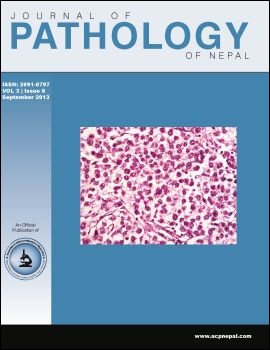Granulomatous inflammation: A histopathological study
DOI:
https://doi.org/10.3126/jpn.v3i6.8994Keywords:
Granuloma, Histopathology, ToxoplasmosisAbstract
Background: Granulomatous inflammation is a special type of chronic inflammation that is being a manifestation of many infective, toxic, allergic, autoimmune and neoplastic diseases and also conditions of unknown etiology.
Materials and Methods: The study included a total of 418 granulomatous lesions, diagnosed from January 2010 to December 2012 in the department of pathology, Tribhuvan University Teaching Hospital, Kathmandu, Nepal.
Results: The median age of the patients with granulomatous lesion was 29 years and the majority of the patients were in the age group of 20-29 yrs with slight male predominance. Majority of granulomas were seen in lymph nodes (41.1%), followed by skin & subcutis (22%), and bone & joints (11.5%). Tuberculosis was the most common cause of granuloma with 258 (61.7%) cases, followed by fungal infections, foreign body reaction, parasites and toxoplasmosis. Out of 258 cases of tuberculosis, lymph nodes were involved in 140 (54.26%) cases, followed by bone & joints (12.79%) and respiratory system (5.42%). The most common type of granuloma was epithelioid (83.5%), followed by epithelioid with suppuration and mixed inflammatory.
Conclusion: The granulomatous lesion is common in third decade of life with slight male predominance. The commonest site is lymph node with tuberculosis being the most common cause and epithelioid being the most common type of granuloma.
DOI: http://dx.doi.org/10.3126/jpn.v3i6.8994
Journal of Pathology of Nepal (2013) Vol. 3, 464-468
Downloads
Downloads
Published
How to Cite
Issue
Section
License
This license enables reusers to distribute, remix, adapt, and build upon the material in any medium or format, so long as attribution is given to the creator. The license allows for commercial use.




